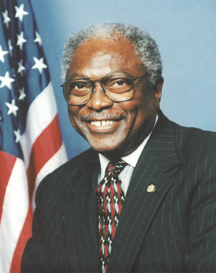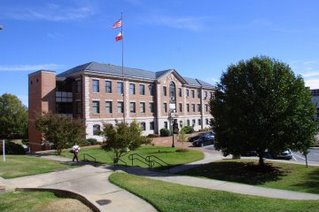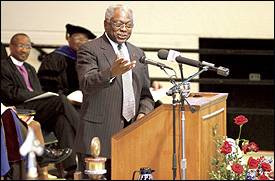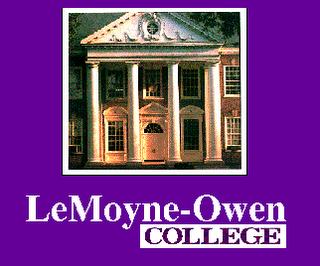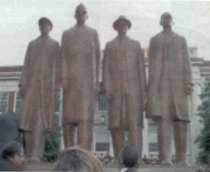
Roughly one of every four undergraduate students who enrolled at N.C. A&T in the fall is on academic probation or suspension this semester, the status given to students who are failing or not making adequate progress toward graduation.
Administrators attribute the high numbers — and the
400 percent increase from fall 2005 to fall 2006 — to a renewed and strict compliance of university policies.
"We were making sure we’re adhering to our policies," said Janice Brewington, A&T’s interim provost. "That number caught some students who may not have been in the mix before ... that we had not picked up or had overlooked or had not been consistent in relationship to applying the policies."
Lee Young, A&T’s director of admissions, said the designation may not mean a student is failing academically.
"If you had been here perhaps with a 3.5 GPA but you were five to six hours under where you needed to be, you may have not been touched before as a probation," he said.
"Now I’m touching you as a probation because I want to get you on point, that even though you are proceeding toward graduation, you’re not doing so as quickly as perhaps you should," Young said.
Yet administrators admit the numbers are a source of concern and have created internal committees to dissect data and alter policies as necessary.
"We know that we’re a good institution," Brewington said. "Do we need to be better? Yes, we need to be better. Are we going to be better? Yes, we’re going to be better.
"We owe it to the students, we owe it to this university and we owe it to this community and this state."
Both Brewington and interim Chancellor Lloyd "Vic" Hackley assumed their current roles in May. It’s not clear why the policies were not strictly followed before the current academic year.
Administrators are working to pinpoint other variables — such as family or financial problems or admissions criteria — that affect the number of students on probation or suspension, Brewington said.
For instance, the school’s average SAT score for new freshmen decreased 60 points in the decade from 1995 to 2005, dropping to 893 from 953. Half of A&T’s top 10 in-state feeder schools have been on a list of low-performing high schools.
"You have to ... take all of that into consideration. That’s what we’re assessing," Brewington said. "If you only look at one portion of the data and don’t look at it as a whole, then you will make decisions that may not be valid decisions."
Examining the numbers
The school created an internal committee in the fall to examine admissions policies, suspension and probation, she said. Other groups are studying retention and graduation rates and the university’s Center for Student Success. Findings are expected later in the spring.
The percentage of students on academic probation — given when students fail to pass a certain number of semester hours and meet a required grade-point average — increased 376 percent, from 374 students in fall 2005 to 1,779 students in fall 2006. Students on probation have one semester to improve, or they will be suspended from the university for a semester.
The percentage of students on academic suspension increased 467 percent in fall 2006 as compared with fall 2005, from 138 students to 783 students.
The number of students on suspension decreased this semester, down 45 percent from 783 students in the fall to 430 students. Young attributed the improvement to students taking the steps necessary to improve their status.
However, the number of students on probation increased 27 percent for the spring semester, from 1,779 students in the fall to 2,264 students. Young attributed that to the increased scrutiny administrators are giving students’ progress.
How A&T comparesThe number of undergraduates on academic probation or suspension at A&T in the fall — 2,562 students for a university with an enrollment of 9,687 undergraduates — was significantly higher than other public universities in the Triad and another historically black institution of comparable size.
* Of the 10,902 undergraduate students enrolled at UNCG last spring, only 5.5 percent were put on academic probation and 2.7 percent on academic suspension, a total of 894 students.
* Winston-Salem State University, which had a student population of nearly 6,000 in the fall, had 144 students on academic probation and 371 on suspension, about 8 percent of the population.
* Florida A&M University, a historically black institution in Tallahassee, Fla., with a student body of more than 12,000, had about 6 percent of its students on academic alert in fall 2005, the most recent data available. At that time, 402 students were on probation and 325 on suspension, said Michael James, the university's registrar.
In the UNC system, the standards for academic suspension and probation vary from school to school, said Kemal Atkins, the system’s director for academic and student affairs.
Because of that, the system doesn’t evaluate schools based on the number of students on probation or suspension, he said, instead focusing on the number of students who earn D’s and F’s or who withdraw from classes.
Nothing from A&T’s data on those measures in the past year reviewed stood out, Atkins said.
Yet the high percentage of A&T students on academic probation or suspension "would be a cause for alarm," he said.
Erskine Bowles, the president of the UNC system, has made improving graduation and retention rates a priority throughout the system.
"There already is a cause for concern across the system because we realize we need to improve the number of our students retained year to year and who graduate, for the economy of the state and for the students themselves," Atkins said.
According to data from the system, only 22.7 percent of freshmen entering A&T in 1999 graduated in four years, and 39.5 percent graduated in six years.
Throughout the UNC system, 34.9 percent of the freshme n entering that year graduated in four years, and 59.1 percent graduated in six years.
All data reported is for students entering college for the first time and on a full-time basis.
This academic year, every university in the system must submit a plan to the UNC General Administration detailing how it plans to improve the rates. The system will work with a consultant to evaluate whether the plans and goals are realistic, Atkins said.



